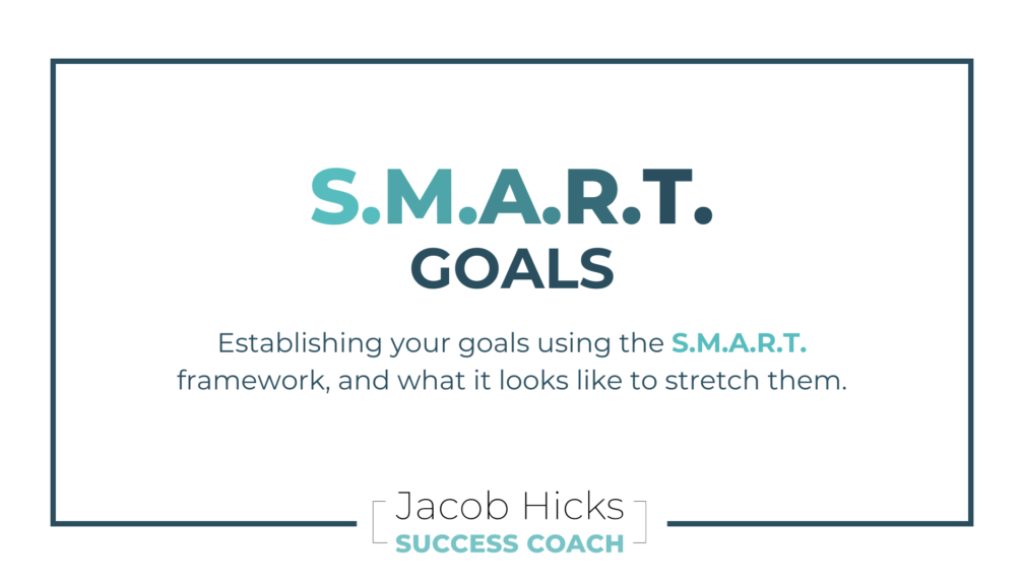Establish S.M.A.R.T. Goals – and stretch them
We are kicking off our series, 6 Habits for Success, with the first habit: how you should establish your goals using the S.M.A.R.T. goal method and what it looks like to stretch them. Soooo…let’s get into it!!!
What are S.M.A.R.T. Goals?
This is an acronym (which will surprise few very) that stands for Specific, Measurable, Achievable, Relevant, and Time-bound. I know what you might be thinking: “Jacob, I love acronyms as much as the next guy…but how do I apply this?”
Specific
A specific goal will answer these questions:
- What do you need to accomplish?
- What steps do you need to take?
- What is necessary for each step to happen?
Example – You want to read more
“I will set aside 30 minutes every day to read during my lunch break.”
Measurable
A measurable goal will give you quantifiable data to determine if you are on track to hit your goal. Jacob’s tip for rockstars: track lead measures instead of lag measures.
A lead measure is something you can control.
A lag measure is out of your control.
(i.e. how many times you went to the gym and how many days you stuck to your diet.)
Example – You want to lose weight
“I want to lose 20 pounds; therefore, I’m going to track how many steps I take each day along with how many calories and macros I’m consuming.”
Achievable
A dose of reality can be good here. Is this goal something you can reasonably accomplish?
- What is your current workload like?
- How busy are you day to day?
- Where would your goal fit into your current responsibilities?
Example – You want a promotion
“I ultimately want a senior management position. I’m going to schedule a meeting with my boss to determine how to improve in my current role on a measurable path to a management position that will later set me up for a senior position.”
Relevant
This is when we start thinking long term. You need to establish where you ultimately want to go. Always start with the end in mind.
- Why are you setting this goal?
- Why are you setting it now?
- Where do you want to go long term?
- How does this goal serve your larger goals?
Example – You are a salesman that wants to grow your territory
“I’m going to focus most of my efforts on my highest performing clients. I know that it is easier to deepen current relationships than to earn new business while also maintaining my thoroughly researched target list.”
Time-bound
You need to know when a goal has been reached.
- What’s your time horizon?
- When will you start implementing?
- When will you be finished?
Example – You want to learn piano
“I’m going to start this week but intend to start slowly. I’ll be playing just five minutes a day this week – then ramp it up to 30 minutes a day by the end of the month.”
Everybody needs a good stretch
When you stretch your muscles, you become limber though you may experience a little discomfort. The same is true for goals. When we stretch our goals, we can achieve more than we originally thought, but we must make sure it is in fact still achievable.
Example – You want to lose weight
Goal
- I want to lose 20 pounds
- By walking 1 mile a day
- Because we desire to be noticeably healthier
- And maintaining a calorie deficit of 500
- Completed in 4 months
Stretch goal
- You want to lose 20 pounds
- By walking 2 miles a day
- Because we desire to be noticeably healthier
- And maintaining a calorie deficit of 600
- Completed in 3 months
Both examples are achievable, but the stretch goal gets us more out of our comfort zone. The more consistently we stretch ourselves, the more comfortable we get being uncomfortable, our comfort zone expands, and we can achieve more.
Ready to take the next step? Download my free S.M.A.R.T. goals template by clicking here! Feel free to print this out, jot down your goals, and place this somewhere you’ll see your goals every day.
